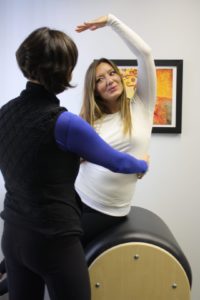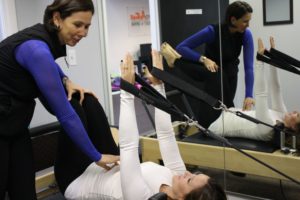Pilates Balance
Balance Your Health
HOW Can You Become Physically Fit?
It’s Your Body

Pilates is a holistic mind-body workout. By preparing our bodies for physical fitness, emphasizing mental focus on our movements, posture and breath control, we can achieve better health.
In essence, we can “inhabit” our own bodies with Pilates training. We will become conscious of our sitting and standing posture as well as how we move while performing everyday activities or exercising.
As we practice Pilates, the student follows verbal cues provided by the instructor who is attentive to our every move. Stress that is stored in the muscles from everyday pressures is released with the flow of movement achieved in Pilates exercises, breathing techniques and body awareness.
Your instructor will help you to restore the balance in your body — strengthening and stretching all of your muscle groups and isolating the weak ones for greater conditioning.
Gain Mobility
 Full body workouts include movement of the spine in all directions while keeping the pelvis steady. Unlike conventional workouts, which produce short bulky muscles, Pilates develops long and lean muscles, like those of a dancer. The results promote strength and elasticity and are pleasing in the mirror as well, building confidence!
Full body workouts include movement of the spine in all directions while keeping the pelvis steady. Unlike conventional workouts, which produce short bulky muscles, Pilates develops long and lean muscles, like those of a dancer. The results promote strength and elasticity and are pleasing in the mirror as well, building confidence!
The frequency of repetitions from weight-bearing exercise is reduced in favor of quality of movement — smooth, flowing and controlled for maximum power and efficiency. During sessions, your teacher will draw your attention to identify proper spinal and pelvic positioning.
You will learn about breath control, posture and correct body alignment. Soon you will become “in tune” with your body. During everyday activities and sports, you will apply your knowledge and use your body more effectively.
As founder Joseph Pilates theorized in the early 1900, continued practice and self-awareness of Pilates spreads to the extremities, creating stability and enhanced awareness of where one’s body is in space during movement!
Create a Healthier You
Restoring function and an evenly conditioned body is healing. Pilates is often used in rehabilitation and sports medicine to prevent injuries, improve performance, and rehabilitate sports injuries. Professional sports teams and athletes include Pilates in their training regimens!
Following surgeries that may cause muscle weakness, like those for breast cancer that may leave a patient unable to fasten her seatbelt, Pilates is often recommended for occupational therapy.
Back pain, typically caused by muscular imbalance, is remedied by Pilates exercises, which evenly conditions the whole body — even the ankles and feet. Traditional workouts tend to overwork certain muscles, and others, not at all. Muscle mass produced by weight training may contribute to joint and tendon injury.
And conventional sit-ups can create an imbalance in muscle groups because the front muscles are overdeveloped but the back muscles are weak.
Strengthening the deep abdominal muscles and those closest to the spine contributes to a strong core. When the center of the body is supported by flat abdominals and a strong back, control is maintained by integrating the trunk, pelvis and shoulder girdle.
Pilates reduces stress, promotes flexibility and balanced strength — the key to preventing injury and allowing us to become physically fit!
